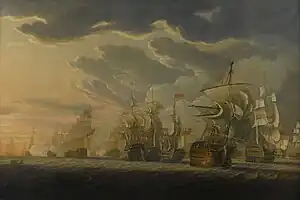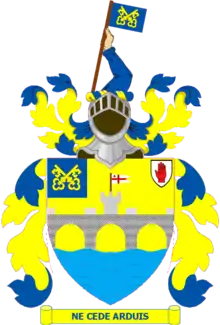Sir Thomas Troubridge, 1st Baronet
Rear Admiral Sir Thomas Troubridge, 1st Baronet (22 June 1757 – 1 February 1807) was a Royal Navy officer. As a junior officer he saw action at the Battle of Sadras in February 1782 during the American Revolutionary War and the Battle of Trincomalee in September 1782 during the Anglo-French War. He commanded the third-rate Culloden at the Battle of Cape St Vincent in February 1797 during the French Revolutionary Wars. He went on to be First Naval Lord and then served as Commander-in-Chief, East Indies, during the Napoleonic Wars.
Sir Thomas Troubridge, 1st Baronet | |
|---|---|
 Troubridge as a rear-admiral, painted 1804-5 by Sir William Beechey | |
| Born | 22 June 1757[1] London |
| Died | 1 February 1807 Aboard HMS Blenheim |
| Allegiance | United Kingdom of Great Britain and Ireland |
| Service/ | Royal Navy |
| Years of service | 1773–1807 |
| Rank | Rear-admiral |
| Commands held | HMS Chaser HMS Lizard HMS Active HMS Defence HMS Sultan HMS Thames HMS Castor HMS Culloden |
| Battles/wars | American War of Independence |
| Awards | Order of Saint Ferdinand and of Merit Naval Gold Medal |
| Relations | Edward Thomas Troubridge (son) |
Naval career

Born the son of Richard Troubridge, a baker,[2] Troubridge was educated at St Paul's School, London.[3] He entered the Royal Navy on 8 October 1773 and, together with Horatio Nelson, served in the East Indies in the frigate HMS Seahorse.[3] He was promoted to lieutenant on 1 January 1781 on the newly-purchased sloop Chaser. On 3 March he returned to Seahorse. In her he took part in the Battle of Sadras in February 1782 during the American Revolutionary War and the Battle of Trincomalee in September 1782 during the Anglo-French War.[3] His first command was the sloop Lizard in October 1782.[3]
Promoted to post-captain on 1 January 1783, Troubridge was given command of the frigate Active and was present at the Siege of Cuddalore in June 1783.[3] After that he transferred to the third-rate Defence.[3] In 1785 Troubridge returned to England in Sultan as flag-captain to Admiral Sir Edward Hughes.[3] He was appointed to the frigate HMS Thames in 1790.[3]
Appointed to command the frigate Castor in May 1794, he and his ship were captured by the French while escorting a convoy, but he was liberated soon afterwards.[3] On his return he was appointed to command Culloden, a third-rate ship of the line, in which he fought at the Battle of the Hyères Islands, led an unsuccessful pursuit of a French squadron in the Aegean Sea, and led the line at the Battle of Cape St Vincent, being commended for his courage and initiative by Admiral Sir John Jervis.[3]
In July 1797 he assisted Nelson in the unsuccessful attack on Santa Cruz de Tenerife.[3] In August 1798, when getting into position for the attack on the French fleet, Culloden ran aground on a shoal near the entrance to Aboukir Bay and was consequently unable to take any part in the Battle of the Nile. At Nelson's request, however, he was awarded the gold medal commemorating the victory.[4]
Troubridge then served in the Mediterranean and was created a baronet on 30 November 1799.[3] In February 1801 he joined the Board of Admiralty as First Naval Lord.[5] Promoted to a rear-admiral on 21 April 1804,[6] Troubridge was appointed to command the eastern half of the East Indies Station, and he went out in Blenheim[3] with his resignation from the Admiralty Board becoming effective in May 1804.[7]
On his arrival the area of command was changed to that of the Cape Station. He left Madras in January 1807 for the Cape of Good Hope. Off the coast of Madagascar, Blenheim, an old and damaged ship, foundered in a cyclone and the admiral and all others on board perished.[4]
Arms
 |
|
References
- Crimmin, P. K. "Troubridge, Sir Thomas, first baronet (1757–1807)". Oxford Dictionary of National Biography (online ed.). Oxford University Press. doi:10.1093/ref:odnb/27765. (Subscription or UK public library membership required.)
- "TROUBRIDGE, Sir Thomas, 1st. Bt. (c.1758-1807), of Asher, nr. Plymouth, Devon". History of Parliament. Retrieved 10 August 2018.
- Laughton, John Knox (1899). . In Lee, Sidney (ed.). Dictionary of National Biography. Vol. 57. London: Smith, Elder & Co.
- Chisholm 1911.
- Rodger, p. 69
- "No. 15695". The London Gazette. 21 April 1804. p. 496.
- "Sainty, JC, Lord High Admiral and Commissioners of the Admiralty 1660–1870, Office-Holders in Modern Britain: Volume 4: Admiralty Officials 1660–1870 (1975)". pp. 18–31. Archived from the original on 7 October 2014. Retrieved 11 April 2015.
- Burke's Peerage. 1949.
Sources
- This article incorporates text from a publication now in the public domain: Chisholm, Hugh, ed. (1911). "Troubridge, Sir Thomas". Encyclopædia Britannica. Vol. 27 (11th ed.). Cambridge University Press. p. 311.
- Laughton, John Knox (1899). . In Lee, Sidney (ed.). Dictionary of National Biography. Vol. 57. London: Smith, Elder & Co.
- Crimmin, P. K. "Troubridge, Sir Thomas, first baronet (1757–1807)". Oxford Dictionary of National Biography (online ed.). Oxford University Press. doi:10.1093/ref:odnb/27765. (Subscription or UK public library membership required.)
- Rodger, N.A.M. (1979). The Admiralty. Offices of State. Lavenham: T. Dalton Ltd. ISBN 0900963948.
Further reading
- O'Byrne, William Richard (1849). . . John Murray – via Wikisource.
External links
- Kidd, Charles, Williamson, David (editors). Debrett's Peerage and Baronetage (1990 edition). New York: St Martin's Press, 1990.
- Leigh Rayment's list of baronets